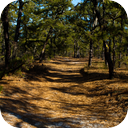(short preview of full seamless looping track)
Walking On Pine Needles
This product is not available in the selected currency.
In Stock
Backordered
Out of Stock
Description
You come out to the forest trail just to have an hour crunching the dry needles under your feet. Somehow the sound of this walk and the strength you feel stomping the ground is enough to settle your nerves after a long day of work, retaking the power that the office steals from you. Perhaps you should find a more productive way to change what you don't like, or simply swallow some aspirin, but you prefer a natural remedy that allows you to get some exercise and doesn't upset your boss. Pines are evergreen, resinous trees growing 3–80 m tall, with the majority of species reaching 15–45 m tall. Pines are native to most of the Northern Hemisphere. The modern English name pine derives from Latin pinus by way of French pin. In the past (pre-19th century) they were often known as fir, from Old Norse fyrre, by way of Middle English firre. Pines are among the most commercially important of tree species, valued for their timber and wood pulp throughout the world. In temperate and tropical regions, they are fast-growing softwoods that will grow in relatively dense stands, their acidic decaying needles inhibiting the sprouting of competing hardwoods. Pine wood is widely used in high-value carpentry items such as furniture, window frames, panelling, floors and roofing, and the resin of some species is an important source of turpentine. Some species have large seeds, called pine nuts, that are harvested and sold for cooking and baking. The soft, moist, white inner bark (cambium) found clinging to the woody outer bark is edible and very high in vitamins A and C. It can be eaten raw in slices as a snack or dried and ground up into a powder for use as a thickener in stews, soups, and other foods, such as Finnish pine bark bread (pettuleipä). Adirondack Indians got their name from the Mohawk Indian word atirú:taks, meaning "tree eaters".
Opps
Sorry, it looks like some products are not available in selected quantity.



